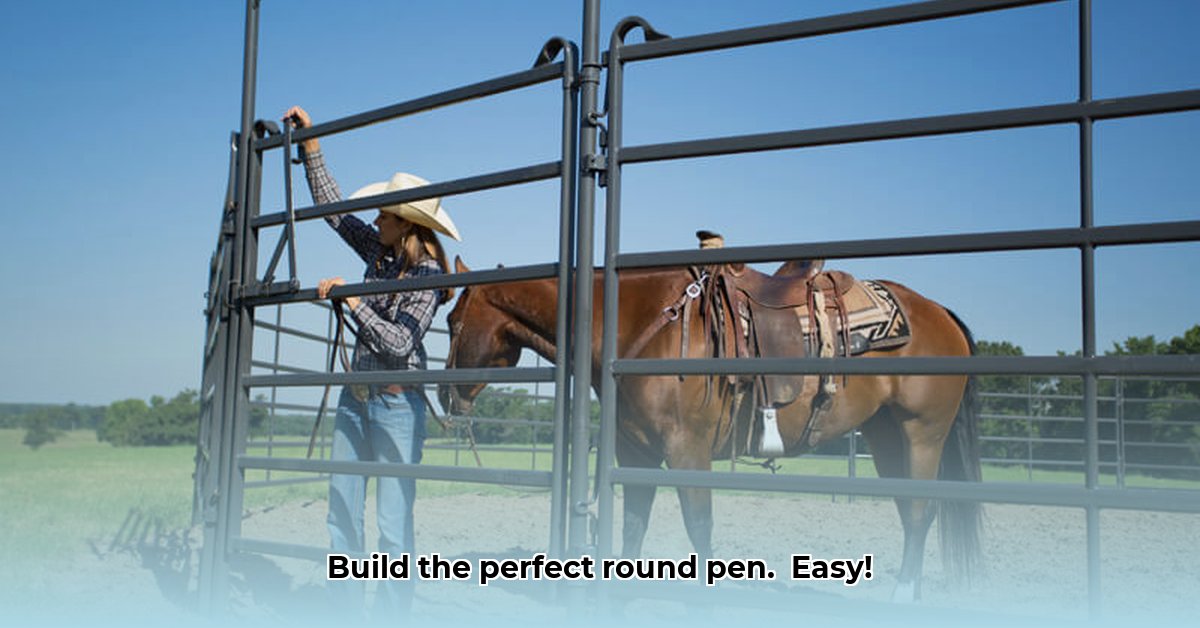
Building a round pen for your horse is a rewarding project that improves training and horse-human interaction. Tractor Supply offers a variety of panels, making it crucial to choose wisely for a safe, durable, and cost-effective setup. This guide will walk you through selecting, installing, and maintaining your round pen for years of reliable use. For more on tools, check out this helpful resource on auger bits.
Choosing the Right Panels: Material and Size
Tractor Supply offers round pen panels in various materials, sizes, and styles. Galvanized steel is a popular choice due to its strength and affordability. However, the quality of the galvanization and steel thickness significantly impact durability. Thicker steel resists bending and denting better, while a thicker, even galvanizing coating prevents rust, extending the panel’s lifespan. Consider these factors:
- Steel Gauge: A higher gauge number (e.g., 11 gauge) indicates thinner steel. Opt for lower gauge numbers for greater strength and durability. (Thicker steel equals greater longevity.)
- Galvanization Quality: Look for panels with a smooth, even coating to prevent rust. Poorly galvanized panels will rust faster, requiring more frequent repairs or replacements.
- Panel Height: Choose a height appropriate for your horse's size and energy level. Taller panels provide better containment for larger or more energetic horses.
- Panel Length: Tractor Supply offers panels in various lengths. Measure your desired pen's diameter to determine the necessary number of panels. Account for gate placement.
Round Pen Panel Costs: A Comprehensive Breakdown
The total cost of your round pen depends on several factors:
- Panel Price: Prices vary depending on the material, gauge, and panel size. Get quotes for multiple options to compare.
- Number of Panels: Calculate the required number based on your chosen pen diameter.
- Gate Cost: Factor in the price of a gate, considering features like latch type and ease of use. Budget for a high-quality gate for enhanced safety and longevity.
- Post Costs: You’ll likely need to purchase sturdy posts separately; their cost depends on material and length.
- Fastener Costs: Include the cost of galvanized fasteners (bolts, clips, etc.) for secure panel attachment. Sturdy fasteners are crucial for longevity.
- Installation Costs: Will you install it yourself, or hire labor? If hiring, factor in labor costs into your budget.
"Planning ahead and comparing costs from different suppliers ensures you get the best value for your investment," says Sarah Miller, an equine expert at the American Horse Council.
Building Your Round Pen: A Step-by-Step Installation
Follow these steps for a successful round pen installation:
- Site Preparation: Clear the area of debris, rocks, and weeds. Level the ground for a stable base. (Uneven ground can cause panel instability.)
- Layout and Measurement: Use string and stakes to create a perfect circle based on your chosen diameter. Precise measurement is critical for a structurally sound round pen.
- Post Placement: Drive posts firmly into the ground at each panel joint. Post depth varies with soil type and climate; research your location's recommendations.
- Panel Installation: Attach panels to posts using heavy-duty, galvanized fasteners, ensuring a tight, secure fit. (Use more fasteners than you think necessary for robust stability.)
- Gate Installation: Securely install the gate, ensuring smooth operation and a reliable latch. Test it multiple times before use.
- Final Inspection: Check all connections for tightness, alignment, and potential hazards. (A thorough inspection prevents accidents and ensures longevity.)
Round Pen Maintenance: For Lasting Results
Regular maintenance extends the lifespan of your round pen and ensures safety:
- Regular Inspections: Check panels and posts for damage, loose connections, or rust. Address minor issues promptly to avoid major repairs.
- Cleaning: Remove manure and mud build-up regularly to prevent corrosion and maintain a sanitary environment.
- Rust Treatment: Apply rust treatment to any affected areas to prevent further damage.
- Repair or Replacement: Replace damaged or severely rusted panels promptly. Consider purchasing spare panels in case of damage.
"Diligent maintenance significantly reduces long-term costs and increases the lifespan of your round pen," advises Dr. David Johnson, a livestock management specialist at Texas A&M AgriLife Extension.
Safety Considerations: Protecting Horse and Rider
A safe round pen is paramount:
- Secure Connections: Ensure all panels and posts are firmly attached to prevent escapes.
- Smooth Surfaces: Check for any sharp edges or protruding hardware that could injure your horse.
- Regular Inspections: Prioritize regular inspections to identify and address any potential safety hazards.
- Supervise Horses: Always supervise horses during use.
Optional Additions: Enhancing Your Round Pen
Consider these additions:
- Shade structures: Provide shade, particularly in hot climates, to enhance horse comfort.
- Additional Panels: Allow for expansion to accommodate future needs.
- Arena surface: Invest in a suitable arena surface for better footing and less impact.
Conclusion: Building Your Dream Round Pen
With careful planning, quality materials, and proper maintenance, your Tractor Supply round pen will provide a safe and effective training area for years to come. Remember, prioritizing safety and focusing on cost-effectiveness throughout the process guarantees a satisfying and lasting investment.